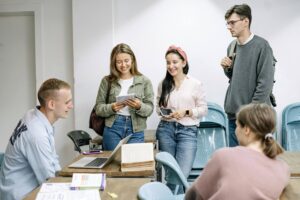Flipped Classroom
"The implementation of activities, designed to tackle student misconceptions and to allow for deeper learning, would simply not be possible without the flipped classroom approach."

What is it?
Flipped classroom is an instructional approach that has students engaging with course content (reading/viewing novel material) before coming to class. Once class begins, students are involved with active learning activities related to the content instead of passively listening to a lecture.
The goal of this approach is to shift the students’ initial contact with the material out of the classroom and allow for more class time to be dedicated to active-learning activities that engage students with the content on a deeper level. Additionally, a portion of the in-class session is often dedicated to addressing student questions/misconceptions.
Skills Promoted
- Self-regulation
- Metacognition
Who's using it?
SALTISE community members who use this strategy and are willing to share advice and/or resources.
| Institution | Discipline | Instructor | Classroom settings |
|---|---|---|---|
|
Vanier College Level: College |
Physics |
Traditional Classroom Classroom size: 30-40 |
|
|
McGill University Level: University |
Electrical and Computer Engineering |
Traditional Classroom Classroom size: 30-40 |
|
|
John Abbott College Level: College |
Physics |
Traditional Classroom Classroom size: 30-40 |
|
|
Cégep André-Laurendeau Level: College |
Organic Chemistry |
Traditional Classroom Classroom size: 30-40 |
|
|
Vanier College Level: College |
Biology |
Traditional Classroom Classroom size: 30-40 |
| Institution |
Vanier College Level: College |
McGill University Level: University |
John Abbott College Level: College |
Cégep André-Laurendeau Level: College |
Vanier College Level: College |
|---|---|---|---|---|---|
| Discipline |
Physics |
Electrical and Computer Engineering |
Physics |
Organic Chemistry |
Biology |
| Instructor | |||||
| Classroom settings |
Traditional Classroom Classroom size: 30-40 |
Traditional Classroom Classroom size: 30-40 |
Traditional Classroom Classroom size: 30-40 |
Traditional Classroom Classroom size: 30-40 |
Traditional Classroom Classroom size: 30-40 |
Why use it?
The main strength is that students come to class eager to have the questions they formulated during their pre-class work answered and discussed. Furthermore, they enjoy directing class discussions with these questions. The time I save employing the flipped classroom approach enables me to dedicate class time to group problem solving sessions and active-learning activities. The implementation of activities, designed to tackle student misconceptions and to allow for deeper learning, would simply not be possible without the flipped classroom approach.
As discussed in the Reflective Writing strategy, the key is getting students to buy in and see the value in doing the pre-class preparation work and associated summaries. The summaries themselves are collected and graded. However, they are not worth many marks and are not graded for correctness (just effort). Thus, students must recognize that the questions they include in their summaries play a vital role in shaping my interactive lectures and any associated activities.
Ready to try it out?
The flipped classroom approach is quite general, and can come in many implementations. Briefly:
STEP 1: Instructor designs online assignments/exercises for students to complete prior to the upcoming class using a preparatory strategy made for this purpose – (e.g. Just in time Teaching (JiTT), Reflective Writing, etc.).
STEP 2: Instructor designs and prepares for in-class activities that allow students to apply and practice the content of the pre-class assignments/exercises (i.e., concepts, procedures, strategies, etc.).
STEP 3: Students (generally as individuals) complete the assigned tasks and post answers to online system.
STEP 4: Instructor reviews the preparatory assignment, briefly if majority of students understood or more in depth if not.
STEP 5: Instructor distributes assignment.
STEP 6: Students engage in an activity that deepens their understanding of the content through practice. See examples of helpful strategies to engage students and/or activities used by others in your discipline.

Strategy Workflow
Helpful resources
Tech Tools
References
Nathaniel Lasry, Michael Dugdale and Elizabeth S. Charles (2014). Just in time to flip your classroom. The Physics Teacher.
Raymond, C. (2010). Do role‐playing simulations generate measurable and meaningful outcomes? A simulation’s effect on exam scores and teaching evaluations. International Studies Perspectives.
Milman, N. B. (2012). The flipped classroom strategy: What is it and how can it best be used?. Distance Learning.
Caroline Cormier and Voisard, B (2018). Flipped classroom in organic chemistry has significant effect on students’ grades. Frontiers ICT.
Videos
Flipping your class: Roles and expectations from Faculty Innovation Center, University of Texas at Austin. UT instructors (Dr. Jen Ebbler, Dr. Sacha Kopp, and Dr. Penne Restad) share how they adapted to the new roles they play within the classroom and helped students adjust to their new roles within the flipped class.
SALTISE EVENT
TO LEARN MORE
For more reading resources go to Articles and Books






